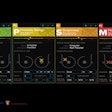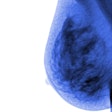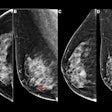Despite overall increases in cancer screening, such as mammography for breast cancer, some geographic areas in the U.S. still show low screening rates, a study published October 17 in JAMA Network Open found.
Researchers led by Pranoti Pradhan, PhD, from the Dana-Farber Cancer Institute in Boston, MA, found that these cluster areas with low screening participation for breast, cervical, and colorectal cancers are tied to socioeconomic disadvantages.
“We observed that global spatial autocorrelation declined over time, suggesting increasing screening in later years reduced geographic disparities,” Pradhan and co-authors wrote.
Despite guidelines and recommendations, cancer screening remains low and variable across geographic and sociodemographic groups. Radiology researchers continue to study how screening adherence is linked to persisting disparities.
Pradhan and colleagues studied geographic and temporal patterns of county-level cancer screening prevalence for breast, cervical, and colorectal cancer between 1997 and 2019, excluding Alaska, Hawaii, and Puerto Rico. They also analyzed sociodemographic factors associated with screening clusters.
The researchers included data from 3,142 U.S. counties and employed spatial analysis of mammography, Papanicolaou testing, and colorectal cancer screening. They reported consistent geographic clustering, with high screening prevalence in the Northeast and lower prevalence in the Southwest.
The team used Global Moran I analysis to measure spatial autocorrelation, which measures how closely related nearby objects or features are to each other in space. A score close to 1 indicates clustering of similar values, while a score close to -1 signifies high dispersion. For the study, spatial autocorrelation declined over time.
The distribution of mammography screening became 83% more uniform in recent years. The Moran I score was 0.57 from 1997 to 1999, but it decreased to 0.1 from 2017 to 2019. This trend points to more uniform screening in the later years of the study period.
For mammography, the team reported the following:
Clusters of consistently high screening prevalence took place in the Northeastern U.S. (Maine, New Hampshire, Vermont, and Massachusetts) over most periods.
Consistently low clusters were found in the Southwest (Texas, New Mexico, and Arizona). The team found no clear spatial patterns for other cluster types.
Clusters that changed from low to high screening prevalence had greater disadvantage based on lower socioeconomic status and a higher proportion of non-white residents than other cluster types.
County-level median home value was lower among low/high clusters (mean, $74,370.45) compared with consistently high screening clusters (mean, $111,820.41).
Counties classified as consistently low also had greater disadvantages relative to consistently high screening counties, suggesting that screening prevalence remained low in areas characterized by lower socioeconomic status.
The study authors cited several factors based on prior research for these trends. These include transportation barriers for patients and the relative lack of health facilities in rural areas compared with urban communities. They also noted that rural residents “may have lower educational attainment, lower incomes, and lower insurance coverage, which may further exacerbate access to cancer screening.”
The authors also called for future studies to incorporate county-level healthcare access characteristics, suggesting that this would help explain why areas of low screening did not catch up to improve cancer screening practices.
Read the full study here.




















